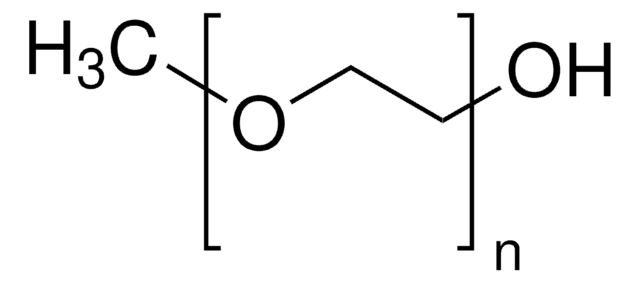Wichtige Dokumente
84797
Poly(ethylenglykol)
BioUltra, 2,000
Synonym(e):
PEG
About This Item
Empfohlene Produkte
Qualitätsniveau
Produktlinie
BioUltra
Form
powder
Mol-Gew.
Mr 1900-2200
Verunreinigungen
insoluble matter:, passes filter test
≤0.001% peroxides (as H2O2):
pH-Wert
5.5-7.0 (25 °C, 50 mg/mL in H2O)
mp (Schmelzpunkt)
50-53 °C
Löslichkeit
H2O: 50 mg/mL at 25 °C, clear, colorless
Anionenspuren
chloride (Cl-): ≤50 mg/kg
sulfate (SO42-): ≤50 mg/kg
Kationenspuren
Al: ≤5 mg/kg
As: ≤0.1 mg/kg
Ba: ≤5 mg/kg
Bi: ≤5 mg/kg
Ca: ≤10 mg/kg
Cd: ≤5 mg/kg
Co: ≤5 mg/kg
Cr: ≤5 mg/kg
Cu: ≤5 mg/kg
Fe: ≤5 mg/kg
K: ≤200 mg/kg
Li: ≤5 mg/kg
Mg: ≤5 mg/kg
Mn: ≤5 mg/kg
Mo: ≤5 mg/kg
Na: ≤200 mg/kg
Ni: ≤5 mg/kg
Pb: ≤5 mg/kg
Sr: ≤5 mg/kg
Zn: ≤5 mg/kg
λ
50 mg/mL in H2O
UV-Absorption
λ: 260 nm Amax: ≤0.1
λ: 280 nm Amax: ≤0.04
SMILES String
C(CO)O
InChI
1S/C2H6O2/c3-1-2-4/h3-4H,1-2H2
InChIKey
LYCAIKOWRPUZTN-UHFFFAOYSA-N
Suchen Sie nach ähnlichen Produkten? Aufrufen Leitfaden zum Produktvergleich
Allgemeine Beschreibung
Anwendung
- as a constituent in the preparation of liquid desiccant solutions
- as a precipitating agent and additive in protein crystallization
- as a representative biocompatible polymer to decipher its interactions with cellular system at molecular level
Lagerklassenschlüssel
11 - Combustible Solids
WGK
WGK 1
Flammpunkt (°F)
281.5 °F - closed cup
Flammpunkt (°C)
138.6 °C - closed cup
Persönliche Schutzausrüstung
Eyeshields, Gloves, type N95 (US)
Hier finden Sie alle aktuellen Versionen:
Besitzen Sie dieses Produkt bereits?
In der Dokumentenbibliothek finden Sie die Dokumentation zu den Produkten, die Sie kürzlich erworben haben.
Kunden haben sich ebenfalls angesehen
Unser Team von Wissenschaftlern verfügt über Erfahrung in allen Forschungsbereichen einschließlich Life Science, Materialwissenschaften, chemischer Synthese, Chromatographie, Analytik und vielen mehr..
Setzen Sie sich mit dem technischen Dienst in Verbindung.
